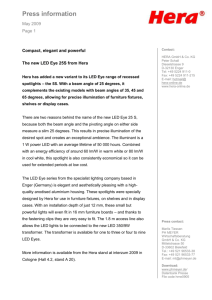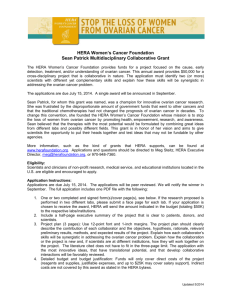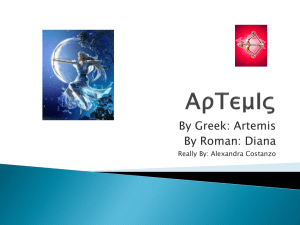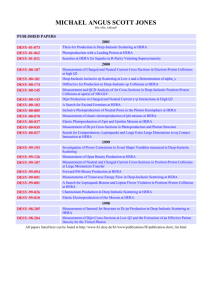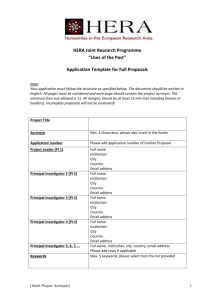2001 European Stakeholders Workshop kfox
advertisement
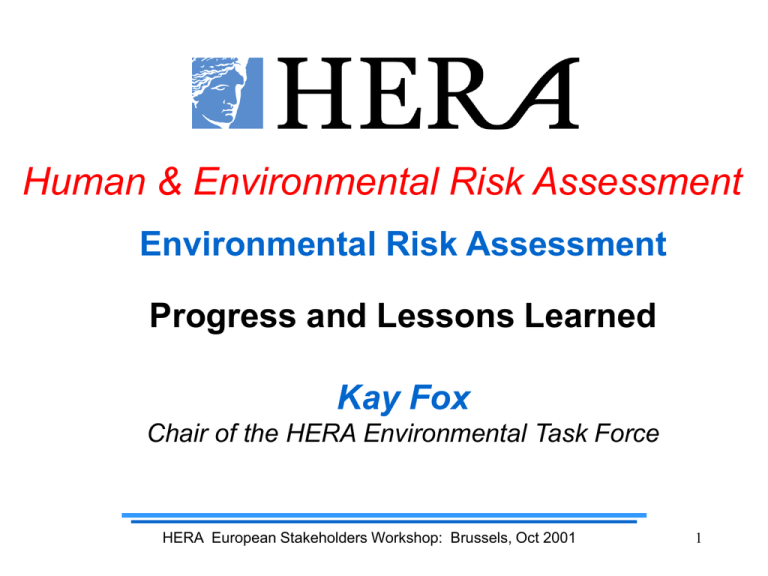
Human & Environmental Risk Assessment Environmental Risk Assessment Progress and Lessons Learned Kay Fox Chair of the HERA Environmental Task Force HERA European Stakeholders Workshop: Brussels, Oct 2001 1 HERA Environment Task Force K. Fox A. Aarts C. Arregui J. Backmann A. Berends G. Boeije D. Calcinai E. Cerbelaud H. Certa R. Elsmore V. Koch Solutia HERA HERA Solvay P&G Sasol Rhodia Sasol McBride Clariant Unilever (Chair) I. Lopez Petresa P. Masscheleyn P&G C. Poelloth HERA P. Richner CIBA W. Schul BASF J. Steber Henkel C. Stevens Dow Corning R. Toy Shell Chemicals R. van Wijk Akzo Nobel T. Wind Henkel HERA European Stakeholders Workshop: Brussels, Oct 2001 2 HERA Environment Goals • 1a. To develop a methodology, based on the TGD, which is specifically tailored to household detergent and cleaning products – Transparent – Good science Speed – Rapid and easy to use Quality • 1b. To carry out risk assessments, and to use them to improve the methodology HERA European Stakeholders Workshop: Brussels, Oct 2001 3 HERA Environment Conclusions specific for European Usage AISE product categories HERA Environmental Risk Assessment starts with EU Technical Guidance Document for New and Existing substances EUSES HERA European Stakeholders Workshop: Brussels, Oct 2001 4 HERA Main focus on chemical substances used primarily in Household detergent and cleaning products Sewer Transport Sewage Treatment Focus on the use and disposal of these substances HERA European Stakeholders Workshop: Brussels, Oct 2001 5 Detergent exposure scenario for EUSES TGD • Begin with EUSES – Environment • Local • Regional – Predators exposed via the environment – Man exposed via the environment HERA European Stakeholders Workshop: Brussels, Oct 2001 6 Detergent exposure scenario for EUSES HERA • Tiered Methodology – Begin with EUSES – Include the HERA Detergent Scenario – Replace selected EUSES values if appropriate • Removal values in Sewage Treatment Plant • Often need Chronic ecotoxicity data – Use all other EUSES initial values HERA European Stakeholders Workshop: Brussels, Oct 2001 7 Detergent exposure scenario for EUSES • EUSES assumes that – the local wastewater treatment plant receives 4 times the average ingredient input – the Standard EU region receives 10% of the total European product consumption • HERA replaces these assumptions with measured values based on laundry detergent product consumption and environmental monitoring data the HERA Detergent Scenario. HERA European Stakeholders Workshop: Brussels, Oct 2001 8 Regional Environmental Concentration Standard EU Region Production 20 million people 200 km 10% of EU Production Formulation Use 200 km Release is based on Production HERA European Stakeholders Workshop: Brussels, Oct 2001 9 HERA Detergent Release scenario HERA Region Release is based on Production population density 200 km Formulation Use ~100% of release 200 km Kg/person/year HERA European Stakeholders Workshop: Brussels, Oct 2001 10 HERA Region Entire EU Switzerland Belgium Paris, Picardie, U. Normandie The Netherlands Population Area, km2 # EU Regions Pop. Density 370000000 3560000 89 104 7325000 39550 0.99 185 10213000 32820 0.82 311 14500000 43000 1.08 337 15739000 33920 0.85 464 EUSES Standard Region 20000000 40000 1.00 500 London and SE +E Northrhine-Westphalia 20452000 17800000 39794 34071 0.99 0.85 514 522 The HERA Detergent Scenario takes the highest population density in Europe HERA European Stakeholders Workshop: Brussels, Oct 2001 11 Fi nl a Sw nd ed N en or w Ic ay el Th a D e e n Ne n m d th ar er k la n A ds u G stri e a Sw rm i tz any er la n Ire d Eu la ro nd pe an Av UK er a G ge re e B ce e Lu l g xe iu m m bu r Fr g an Po c rt e ug a Sp l ai n Ita ly kg/person/year And the highest laundry detergent usage 1998 per capita detergent consumption by country 14 12 10 8 6 4 2 0 HERA European Stakeholders Workshop: Brussels, Oct 2001 12 To generate the maximum regional release for household laundry products 200 km 200 km This is 7% of the European consumption volume HERA European Stakeholders Workshop: Brussels, Oct 2001 13 HERA • Product use and substance use data are expected to be similar, for most widely used household detergent and cleaning ingredients. • Each HERA Substance Team will consider any areas of high regional usage for their substance, and will modify the HERA regional default if appropriate. Fragrance F HERA European Stakeholders Workshop: Brussels, Oct 2001 14 EUSES Release from LOCAL sewage treatment facility STD. EU Region Local treatment plants TGD - Local plant 4 A reasonable worst case treatment plant receives 4 times the average load HERA European Stakeholders Workshop: Brussels, Oct 2001 15 Experimental data HERA Comparison with sales shows 90% of sewage plants receive less than 1.5 times the boron sold in laundry detergent Frequency Boron in effluents: 50 treatment plants NL 7 Germany 6 Italy 3 UK 34 plants 8 7 6 5 4 3 2 1 0 120% 100% Frequency 80% Cumulative % 60% 40% 20% 0% 0 0.4 0.8 1.2 1.6 2 2.4 Boron measured / Boron calculated HERA European Stakeholders Workshop: Brussels, Oct 2001 16 • HERA uses 1.5 times, not 4 times the average per capita consumption to determine a realistic worst case for the sewage treatment plant input. • Each HERA Substance team will consider any areas of high local use and will modify this HERA value if appropriate. HERA European Stakeholders Workshop: Brussels, Oct 2001 17 Summary - HERA Detergent Scenario 100%, not 99%, of ingredient used goes to the local treatment facility Region 7%, not 10% of ingredient STD. EU Region 1.5 Local sewage treatment - 1.5 is worst case, not 4. HERA European Stakeholders Workshop: Brussels, Oct 2001 18 So - How well does it work? • As well as for boron and some surfactants, monitoring data are available for FWA-5 – might be subject to local usage patterns • FWA-5 data shows Hera Detergent Scenario is still conservative - i.e. predicts a higher environmental concentration than found experimentally. HERA European Stakeholders Workshop: Brussels, Oct 2001 19 HERA Lessons learned - Environment • The HERA detergent scenario, based on measured data for boron in laundry detergent, works - as shown by FWA -5 • Production and Use data – HERA is identifying the data locations within companies/organisations – HERA is building the network to deliver the data we need HERA European Stakeholders Workshop: Brussels, Oct 2001 20 HERA Lessons learned - Environment HERA sponsor companies are aware • Hazard data needs are often “higher tier” – Chronic or higher “non-SIDS” data • Environmental exposure - more realistic data often needed – Sewage treatment plant removal data – Environmental monitoring data very helpful HERA European Stakeholders Workshop: Brussels, Oct 2001 21 HERA Conclusions - Environment • HERA is building a focussed Risk Assessment method – based on the EU TGD – applicable to “HERA” products • HERA is assembling the Network to deliver focussed risk assessments – good science – transparency – comparatively rapid, and easy to use HERA European Stakeholders Workshop: Brussels, Oct 2001 22 Thanks! • To HERA for providing the Challenges! • To the HERA Environment task force for help with the Solutions • To ERASM and the Environment Agency for England and Wales for funding the boron monitoring work • To the monitoring staff who collected the samples in all weathers! • To you for listening! HERA European Stakeholders Workshop: Brussels, Oct 2001 23
